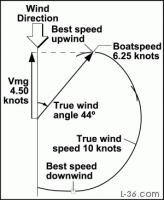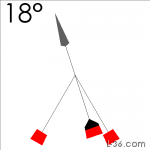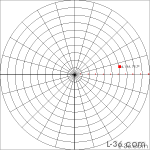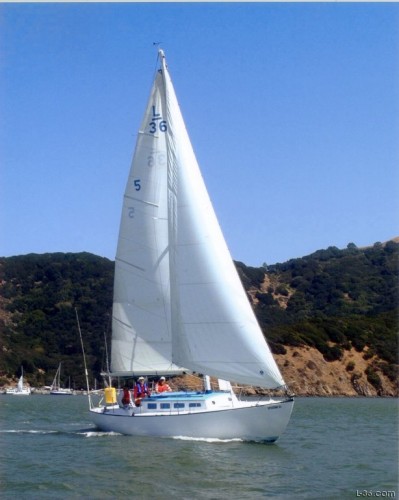Velocity Headers
By Allen Edwards
Introduction
I don't think there is a subject so misunderstood than velocity headers. They can take an entire fleet and get them to all stop dead in the water where a boat that recognizes what it going on can sail right through them. I know because I have done it. We went from last to first to finish in a fleet where we were neither the biggest, fastest, or lightest boat and yet there they all were stopped as we went right by, sails luffing away. Here is a video of that race.By a minute into this video our main is luffing but a bit later we have slowed down enough to be sailing again. Meanwhile, the other boats are trying to build speed back up from having stopped their boats. We crossed the line first in our fleet.
What is a velocity header?
A Velocity Header is a shift in the apparent wind forward due to a change in the true wind velocity without any change in the true wind direction. The correct response to a velocity header is to sail in the direction you want to go until your boat slows down to the target speed for the lighter winds.What Target Speeds

 Target speeds are the boat speed that gives you the maximum velocity made good (VMG) for a given wind speed. HERE is a series of articles on the subject. The goal of the articles is to come up with a table of target speeds. Some boats have published polars. HERE are some I have found. The polar diagram on the right shows boat speed vs heading relative to the wind for a 10kt wind. the object is maximum speed toward the wind and in this diagram it is at 6.25kt. If you head up, you go slower both in boat speed and VMG. If you fall off, you go faster in boat speed but slower in VMG. The boat speed that gives you the best VMG is your target boat speed and it turns out that boat speed is the most sensitive indicator of being at this optimum point. You just cannot measure true wind angle accurately enough. The targets for my boat are at the left. The table has a column of true wind speeds (this table also has the corresponding apparent wind speeds). Then look across the row and see the target boat speed. This table also shows the target wind angle and many people sail to a target apparent wind angle. It turns out that, as a measurement readout, boat speed is much more sensitive to your optimum target than is any wind readout. By that I mean that a significant change in velocity made good is more noticeable on a knot meter than it is on a wind vane. Keep the boat at your target speed, not too fast and not too slow, and you stand the best chance to be going as fast toward the wind as possible.
Target speeds are the boat speed that gives you the maximum velocity made good (VMG) for a given wind speed. HERE is a series of articles on the subject. The goal of the articles is to come up with a table of target speeds. Some boats have published polars. HERE are some I have found. The polar diagram on the right shows boat speed vs heading relative to the wind for a 10kt wind. the object is maximum speed toward the wind and in this diagram it is at 6.25kt. If you head up, you go slower both in boat speed and VMG. If you fall off, you go faster in boat speed but slower in VMG. The boat speed that gives you the best VMG is your target boat speed and it turns out that boat speed is the most sensitive indicator of being at this optimum point. You just cannot measure true wind angle accurately enough. The targets for my boat are at the left. The table has a column of true wind speeds (this table also has the corresponding apparent wind speeds). Then look across the row and see the target boat speed. This table also shows the target wind angle and many people sail to a target apparent wind angle. It turns out that, as a measurement readout, boat speed is much more sensitive to your optimum target than is any wind readout. By that I mean that a significant change in velocity made good is more noticeable on a knot meter than it is on a wind vane. Keep the boat at your target speed, not too fast and not too slow, and you stand the best chance to be going as fast toward the wind as possible.
The Pre Shift condition
12 kt wind, 6.1kt boat speed, 45 degrees to wind.
For this example I am going to assume you are sailing in 12 knots of wind and you sail into an area where the wind is 4 knots. First lets look at the 12 knot condition and see what the boat is doing. Looking at the table above we see we are sailing 6.1 knots and we are likely sailing at 45 degrees to the true wind, a typical heading upwind. We can use the wind angle calculator HERE to see that the apparent wind angle is 30 degrees. At 30 degrees of apparent wind, the windex is lined up perfectly and everyone is happy.The Velocity Shift Hits
Header! Fall off! No - TACK! Oops, Stopped.

 When you hit the lighter air, you are still going 6.1 knots and if you stay on course we can look at the calculator to see what the apparent wind would be for 4 knots. It is 18 degrees. You have hit a header. Most people will fall off to get back to full sails and a windex back at 30 degrees. Remember, we are still at 45 degrees to the true wind so theoretically this should be a good course, we just don't know it. To get to 30 degrees with a boat speed of 6.1 knots we need a true wind direction of 80 degrees. Holly smoke, we are sailing almost directly away from where we want to go, lets tack! So now you tack back and are headed almost directly into the 4 knot wind and probably not moving at all. This is actually the typical response of most boats to these conditions. It is actually worse than I described because the action of turning the boat is going to backwind the jib and make you think you should tack back ever sooner and in less drastic conditions than what I am describing. In the video above, we were last and all the boats in front of us stopped. You can see them tack off to the right and out of the frame. But we didn't. What did we do?
When you hit the lighter air, you are still going 6.1 knots and if you stay on course we can look at the calculator to see what the apparent wind would be for 4 knots. It is 18 degrees. You have hit a header. Most people will fall off to get back to full sails and a windex back at 30 degrees. Remember, we are still at 45 degrees to the true wind so theoretically this should be a good course, we just don't know it. To get to 30 degrees with a boat speed of 6.1 knots we need a true wind direction of 80 degrees. Holly smoke, we are sailing almost directly away from where we want to go, lets tack! So now you tack back and are headed almost directly into the 4 knot wind and probably not moving at all. This is actually the typical response of most boats to these conditions. It is actually worse than I described because the action of turning the boat is going to backwind the jib and make you think you should tack back ever sooner and in less drastic conditions than what I am describing. In the video above, we were last and all the boats in front of us stopped. You can see them tack off to the right and out of the frame. But we didn't. What did we do?
The Correct Response
4 knots wind, 1.9 kt boat speed, 47 degrees to wind.
The goal is to be sailing at 45 (plus a couple in the light wind) degrees to the true wind at our target speed of 1.9 knots. Not very fast compared to the 6.1 knots we are going but it is our target speed. What should we do? The answer is that we want to slow the boat down until we are at our target speed at which point we will be sailing again. But we want to take as long as possible to slow the boat down. We want to coast and we want to do it in the direction we want to be going. Typically the direction we want to go would mean that we want to head up and not fall off. But changing course will slow us down quickly and we would then need to fall off once we got down to our target. Plus, we might have miss judged our target and slow down too much. So the best thing is to probably not head up but certainly not fall off to try and fill the sail. The main has centered itself and is luffing. But what about the jib? It is back winded -- release it! That's right, just let it go so it isn't slowing you down. When your windex gets back to 30 degrees and your boat speed has bled off, trim.Easier Said Than Done
Practice Makes Perfect.
There are many obstacles to pulling this off. First is that you have to be correct in your evaluation that this is a velocity header and not a true header. Next you probably have crew yelling at you that you are luffing and need to fall off. Best to teach them about velocity headers ahead of time. The best way to learn about velocity headers is to get in one, fall off, tack, stop the boat, and watch some other boat sail by you. That is how I learned about them.What About Velocity lifts?
A Much Smaller Gain
Velocity lifts are situations when you are in light winds and you enter a strong wind that has the same direction as the light wind. Most people will head up because when the stronger wind hits, you will feel a lift. In our example, you will be 41 degrees apparent. But you are sailing in the right direction, just too slow. You want to be going 6.1 knots, your target speed, and you are going 1.9 knots (but not for long no matter what you do). The correct response is to let the sails out, hold your course, and get to 6.1 knots as quickly as possible, then trim. Again, you will have crew yelling to head up in the puff but if you are correct and it is not a puff, hold your course and accelerate instead of heading up. If it is a puff, well maybe you called it wrong. No matter what you do in a velocity lift, you will be going 6.1 knots soon enough and you won't stop the boat. They are much less dangerous than velocity headers, which is why this article is focuses on the former and not the latter.A Picture of Papoose
 This picture has nothing to do with this article. It is always on the blank page I start with so this time I though I would leave it here.
This picture has nothing to do with this article. It is always on the blank page I start with so this time I though I would leave it here.
NOTICE: Some pages have affiliate links to Amazon. As an Amazon Associate, I earn from qualifying purchases. Please read website Cookie, Privacy, and Disclamers by clicking HERE. To contact me click HERE. For my YouTube page click HERE